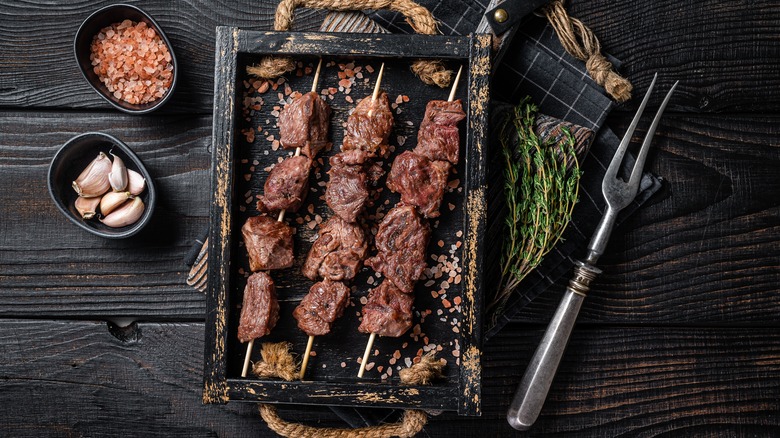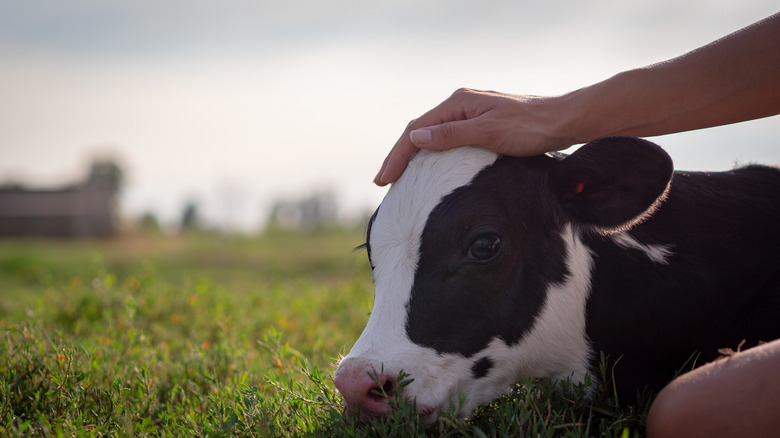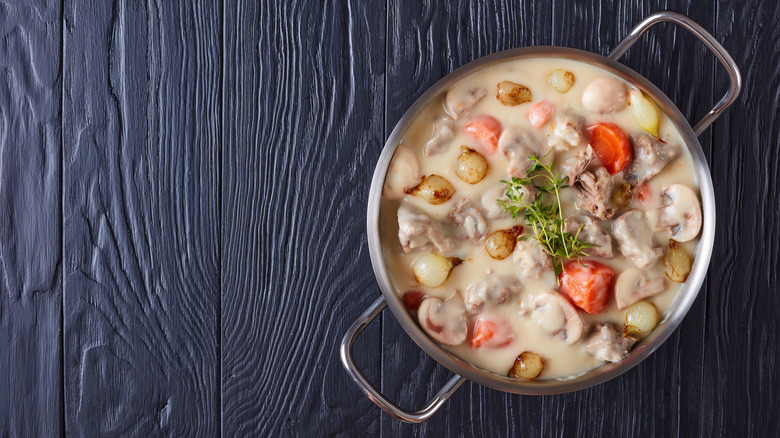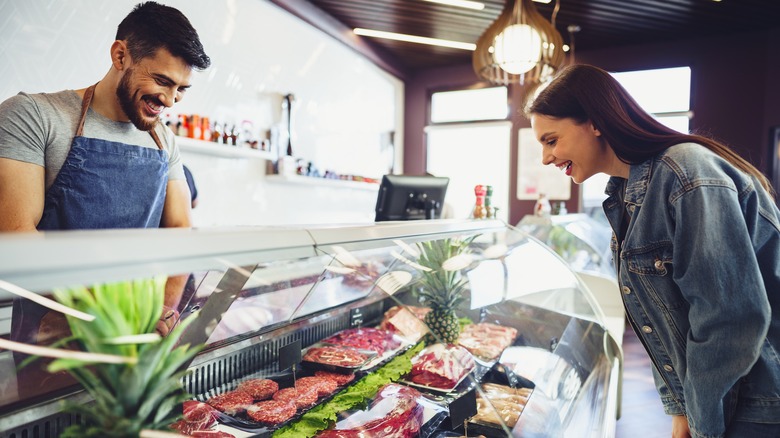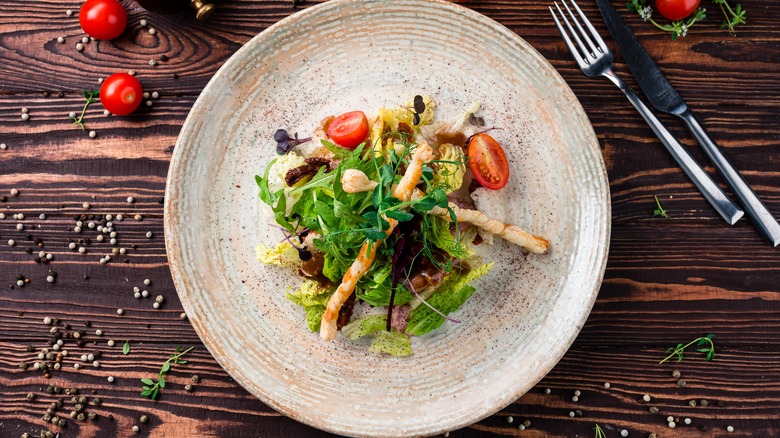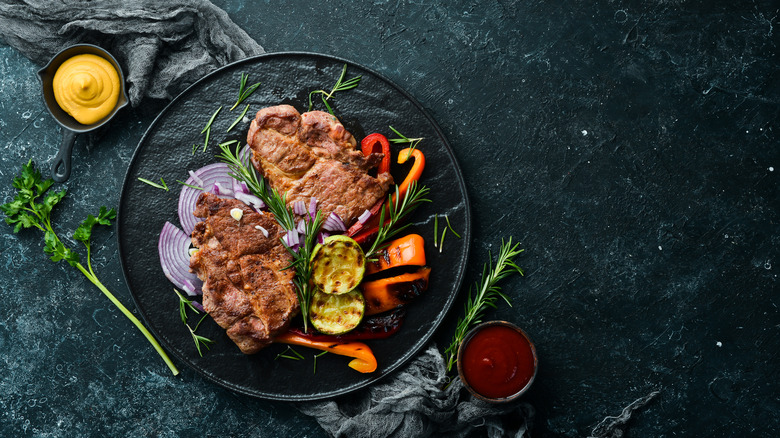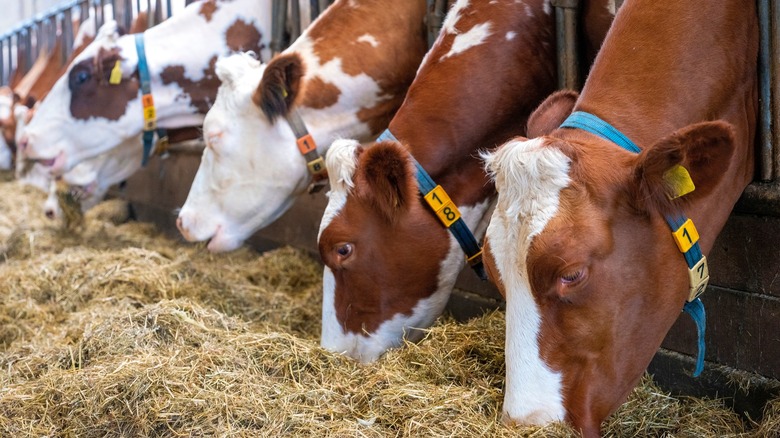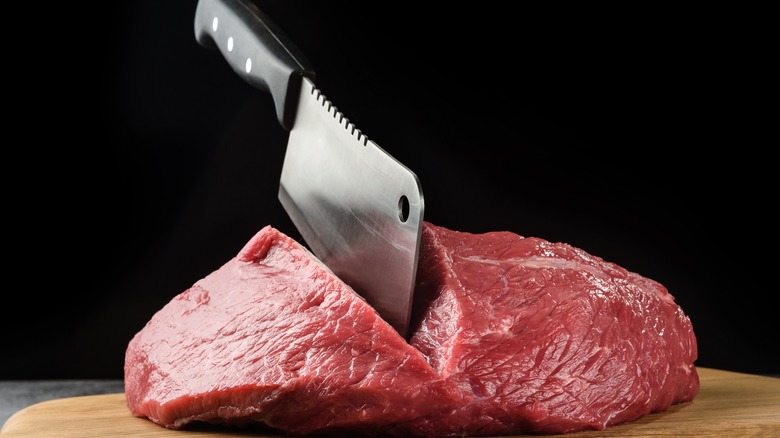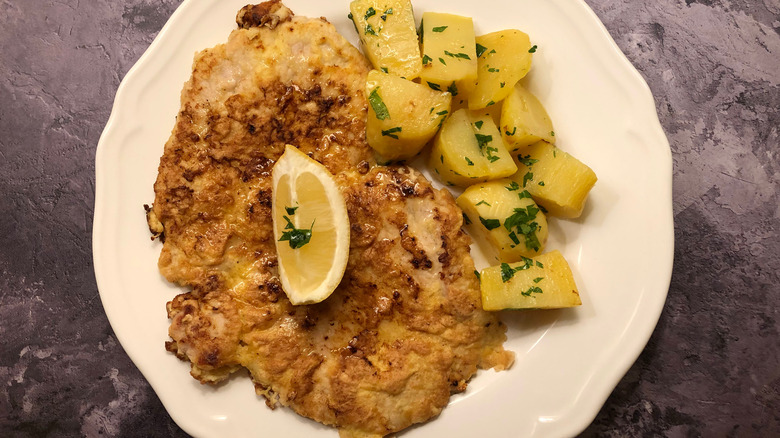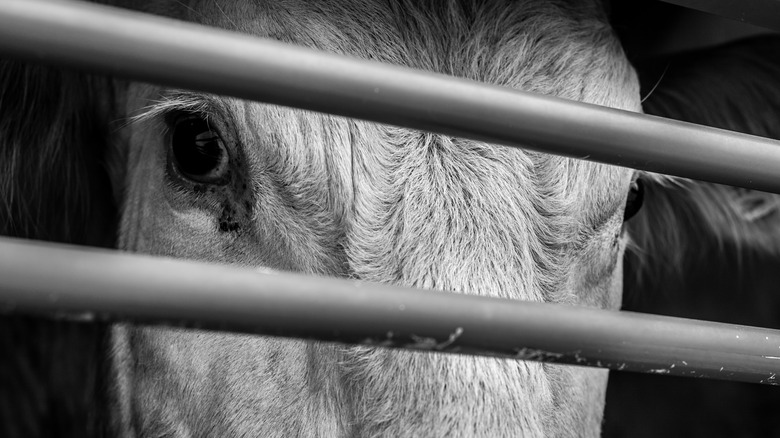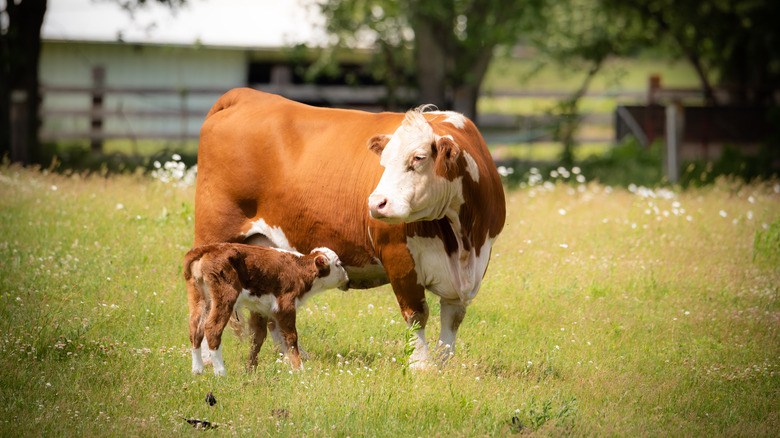10 Things You Should Know Before You Order Veal
Veal is a luxury meat in demand by many chefs and diners alike because of its tender texture and refined flavor. Often considered a delicacy, veal is more likely to be served in high-class, specialty restaurants, partially because of its price but more so because of its complex flavor profile that offers a unique experience for your palate.
Veal is a much-loved meat worldwide but has seen declining consumption in the U.K. and the U.S. for reasons we'll get into later. It's still eaten a lot in Europe, with diners on that continent accounting for 82% of the world's consumption of veal, according to Generation Vegan. It's an essential ingredient in many complex dishes, such as blanquette de veau and Pariser Wiener Schnitzel — which is different from regular schnitzel. It's also loved by multiple celebrity chefs, including Thomas Keller, who uses it to create a meaty stock, as well as Michelin star chef Marcus Wareing.
It's clear that veal occupies a position as an ingredient for elite cooking and provides diners with a sensational taste worth experiencing. Before you order this meat at a restaurant, or attempt to cook it yourself, though, here are a few things you should know.
1. Veal is meat from a young calf
For those who don't know, veal is a type of beef. However, instead of coming from adult cows, veal comes from calves usually no older than 18 weeks and weighing under 450 pounds. This massively affects the meat in terms of flavor. Veal has a distinct taste that isn't dissimilar to regular beef; it's just a lot leaner.
Unlike regular beef, which usually comes from male cattle due to their higher testosterone levels that help build muscle, which means more meat per bull, veal can be made from either male or female calves. That said, you'll find that most veal is produced from male calves, as heifers (the name for female cows that haven't given birth yet) can contribute to the dairy industry, a massive farming sector in the U.S. that generates $29.75 billion a year, according to Statista.
When humans started eating the meat of young calves is a bit of a mystery, and the dish has roots in ancient history, as veal was mentioned multiple times in the Bible, referred to as a 'fatted calf'. However, veal is widely revered today due to its apparent enhanced taste and texture that's unique compared with regular beef.
2. Veal tastes different from beef
When ordering a restaurant dish containing veal, knowing what kind of flavors and tasting notes you can expect is useful. As veal is from cattle, most first-time diners expect it to taste similar to beef but are usually surprised to find that it has a more complex gastronomical structure.
You'll first notice that veal has a much lighter taste that can be described as delicate or neutral. It isn't as forward as standard beef, which is often described as strong and sharp. In most dishes, beef can dominate the entire creation, releasing a rich, umami taste. Veal is more understated, making it an excellent canvas for chefs to build on, as it accents other ingredients instead of overpowering them. It works brilliantly with roasted vegetables, but if you're looking for a great recipe showcasing veal's full flavor profile, try Micheal Symon's braised veal shanks with gremolata.
In addition to the taste, veal has a much more soft texture and isn't as tough as beef, and if the calf is raised right, its meat will have no marbling, giving it a velvety mouth feel that isn't dissimilar to some white meat like fish or chicken. This happens because the calf is young and hasn't developed much muscle. This also helps the veal become juicer as well. Regarding looks, veal is either light pink or white, depending on the age at which the calf was butchered, making it a distinct dish, especially when compared with regular beef.
3. There are multiple cuts of veal you can eat
Much like standard beef, veal is cut from multiple areas of the calf, and each section offers a slightly different taste and use. Unlike how larger, adult cows are cut into sides when first butchered, this isn't necessary with veal, as calves are so small. When getting your cuts of veal, the sections have different names when compared to the regular beef counterpart. The front half of the calf is known as the foresaddle, and the rear is known as the hindsaddle. It's from these larger quarters that the various cuts of veal are taken.
According to Lobel's of New York butcher shop, the hindsaddle of veal contains cuts like the sirloin — from the top of the cow's back — as well as the rump, leg, and hind shank. These cuts are super tender and great for roasting. They can also be carved into cutlets for dishes like scaloppini.
From the foresaddle, you can also get veal rib. These are great for roasts, or you can cut chops out of them to pan grill or broil. You can also get some cheaper cuts from the foresaddle, too. The neck of veal is perhaps the most inexpensive cut and is best used for stew or ground-up once bones are removed to make veal burgers. It's also the toughest part of the veal, so getting this cut is less desirable as it doesn't have the sought-after texture that other veal cuts have.
4. Veal costs more than regular beef
Veal is a particular type of meat that requires great care from farmers who rear the calves, and it must be cooked well for it to taste amazing. These factors mean that the cost to buy veal at a restaurant will be pretty pricey, inflated even more as veal dishes are typically served at high-class and Michelin-starred establishments. Another factor influencing the cost is that veal is in much less supply than typical beef. It's not as abundant as cuts from adult cattle, meaning that its scarcity can generate a greater price.
When purely buying the meat, you'll find that the prices are similar at first glance. For example, when comparing veal to grass-fed beef on the website for the D'Artagnan meat supplier, you'll see that a striploin of veal costs around $10 more than a regular grass-fed beef striploin. Although close, this doesn't factor in the weight of each cut, as you'll get around 3 to 5 pounds more of beef at listed prices. When converted to find out the price per pound, veal costs about $32 per pound, whereas beef costs close to $20 per pound. And this is just one cut of meat.
What can help take the sting off these prices is that veal is much more likely to be eaten as a special treat and isn't an expense you'll often be paying. Avoid being put off by the price tag, so you don't miss out on some fantastic meat.
5. Veal can sometimes be the healthier option
Veal isn't just a superior version of beef in terms of taste, according to some chefs. It also has the potential to be a much healthier option for you when compared with regular beef in specific categories. In terms of nutrition, veal has more vitamins, whereas beef is filled with minerals, which makes sense as veal calves are purposely deprived of iron. In terms of this mineral composition, beef has 67% more zinc and 60% more iron in it, according to Foodstruct. In contrast, veal will have a higher concentration of B vitamins, which can help with metabolism and energy transfer and allow you to maintain healthy skin.
When looking at the calorie content, beef is higher in calories. The general rule is that regular beef has about 20% more calories than veal, making veal the leaner option. Beef also has a lot more fat on average, as veal is almost fatless, making it a little more difficult to cook in certain ways. Veal does have more cholesterol, which is worth considering when choosing between them. Despite that, if you want to keep your calories down and need lean meat with very few carbs that can also help improve your metabolic rate, veal can be one of the healthiest red meats you can eat.
6. The highest producer of veal is a tiny European nation
We've already established that most of the world's veal is consumed in Europe. However, you may be surprised that despite Germany, France, and Italy being the leading consumers of veal, none of these three countries leads the statistics in producing the most veal. In fact, the top country for veal production is the Netherlands, with it slaughtering an estimated 1.5 million calves annually.
Although this may be surprising initially, it makes more sense when you consider that veal is a by-product of the dairy industry, a major industry in the Netherlands. The country was the third-highest dairy exporting nation in the world in 2019, according to Darigold. In addition, the Netherlands has about 1.57 million dairy cows, per Statista, with each producing at least one calf a year to keep up with milk production. Many of these calves born to dairy cows will be male, which is pointless for dairy farming, and they won't have the meaty genetics for standard beef. So, to stop them from going to waste, they're used to make veal.
Despite this massive production, it doesn't seem that the Dutch are that into veal, with 90% of its products being exported worldwide to places like France, Italy, and of course, the U.S.
7. You shouldn't eat veal rare
Another way that veal differs significantly from beef is that, unlike steak, which is perfectly safe to eat rare, veal needs to be cooked longer. Beef can be eaten rare because any bacteria building up on the steak is usually only on the outer layer, which is seared when cooked rare, making it safe to consume. On the other hand, because the calf used for veal hasn't had the nutrients needed from its mother's milk when reared, it's more likely to have infections and other issues, which means its meat needs to be sterilized during the cooking process.
USDA recommends that items like veal steaks and chops are cooked to an internal temperature of at least 145 degrees Fahrenheit to ensure that they're safe, which is the temperature required for meat to be medium rare. To ensure that the veal cooks properly, you need to add a bit of fat, as the meat doesn't have much of its own. Duck fat works great with veal, creating a more complex flavor.
Be aware that your veal's color doesn't always indicate whether it's rare. Due to its tenderness and natural pinkness, veal can still look pink even when it's reached the required internal temperature of 160 degrees Fahrenheit. This means that if it's looking a little flush despite reaching that temperature, you should still be able to eat it without any problems. That said, veal is most often cooked well done.
8. There are multiple fantastic dishes that use veal
Veal is versatile and can be used in a variety of dishes, including stews, roasts, and other concoctions. In fact, because of veal's versatility, chefs have been known to be pretty playful with this meat. The result is that the veal dish you order in one restaurant can be drastically different from the same named dish from another restaurant. Furthermore, as veal has been used in various countries, many dishes are filled with each location's culinary flair.
For example, you can enjoy Cökertme Kebabi, which Turkish Style Cooking describes as a marinated veal kebab that can be traced to the Bodrum area of Turkey. Alternatively, you can also try blanquette de veau, a veal stew considered a classic French dish. It's made by simmering the veal in white stock, making sure not to brown the meat while cooking. The result is a creamy dish.
If you want to make a veal dish at home, the easiest recipe may be veal schnitzel. The full recipe can be found here on Great British Chefs, but essentially it is made by covering veal escalopes in a panko breadcrumb mix and shallow-frying them in a skillet. You can also try the delicious Veal Sweetbreads, which are sure to blow your mind.
9. Veal is a controversial dish
Veal has gotten a lot of attention over the last decade or so, particularly from animal welfare activists. This is because many people consider veal production to be exploitative and inhumane, even more so than standard animal slaughter for other meats.
There are various areas of contention. For example, one major ethical issue, according to Treehugger, is that veal calves are separated from their mothers almost immediately, causing them a great deal of stress. Plus, being separated from their mother's milk can cause calves to have health problems, too. In addition to this, the diet that veal calves are fed is sometimes purposely insufficient for the animal. Most veal calves are given a liquid milk replacer that lacks the iron required to be healthy. This turns the calves anemic, creating the white-colored meat that veal is known for once the calves are slaughtered.
Another crisis of consciousness is the fact that the animals are slaughtered so young and thus don't have an opportunity to first experience life. Most calves used for veal are slaughtered before the 6-month mark, but there's an even more controversial type of veal known as bob veal, which comes from calves that are only a few weeks old. Although these are super rare in Europe and the U.K., 15% of all veal produced in the U.S. comes from bob calves, according to USDA.
10. Changes have been made to how veal can be produced
In the past, the rearing of calves for veal and the practices around the production of veal were far less humane than what they are now. To prevent these calves from building any muscle that would ruin their tender texture, calves used to be kept in dark, cramped cages or crates that prevented them from moving. In addition, most farms only fed these calves milk, which left them pretty malnourished. That in turn helped to create that velvety texture that veal is known for.
Today, things have changed, and there are now many regulations around what can be done in connection with the production of veal, particularly in Europe and the U.K., where most of the world's veal is produced. According to RSPCA Assured, veal crates were banned in 1992 in the U.K. and in 2006 in the European Union. These devices were used to lock up calves. Many farms now allow their calves to move around freely. Although most calves used for veal are still reared on milk, many farms feed their calves fiber-filled meals and give them a varied diet, which alters the meat slightly, leading to what's called rose veal.
In terms of U.S.-produced veal, there is more potential for cruelty, as there is no federal law banning veal crates. According to ASPCA, only Arizona, California, Colorado, Kentucky, Maine, Massachusetts, Michigan, Ohio, and Rhode Island have banned or started to phase out the use of veal crates.
